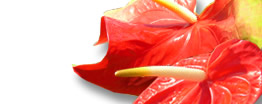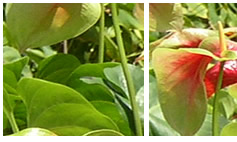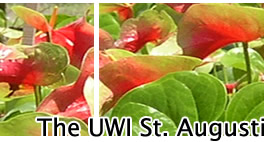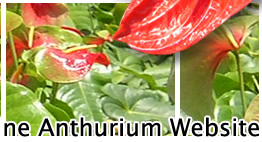 |
 |
||||
 |
 |
 |
|||
|
|
Pest & Diseases of Anthurium in the Caribbean Anthracnose | Bacterial blight | Bacterial leaf spot | Bacterial wilt | Nematode decline | Leaf cutting ants | Snails and slugs Bacterial leaf spot Bacterial leaf spot disease of anthurium, caused by Acidovorax anthurii, was first observed in the 1980s in the French West Indies, namely Guadeloupe and Martinique. It was later observed in Trinidad and Tobago in the early 1990s. Symptomology The disease produces both localized and systemic symptoms. Initially, the localized symptoms develop as angular lesions, oily in appearance and located either on the under-surface of the leaves and spathes, near the veins or along the margins. The lesions are surrounded by a chlorotic halo, which enlarges into black necrotic zones, darkening with age and resulting in deformed leaves. Some researchers have also observed white exudates oozing from the margins of the lesions when the humidity is high. On the spathes, the necrotic spots are surrounded by violet halos. Infection can progress in the veins, and eventually lead to rotting and abscission of leaves and cut-flowers. Systemically infected plants show water-soaked areas at the junction between the petiole and leaf veins and general chlorosis of leaves. At the midrib, veins and leaf margins, typical translucent water soaked areas are evident, which eventually become necrotic. Many times, when the parent plant dies, multiple suckers, which may or may not show foliar symptoms, develop. Dissemination: The disease is highly contagious and the pathogen spreads by excessive water splashing (rain or irrigation), movement of infected soil, and contact with infected plant material, tools (from leaf pruning, harvesting) and persons walking through infected plants. Control measures: It can be controlled using cultural practices and applying chemicals. Cultural practices include the routine removal and burning of infected leaves, cut-flowers and plants; regular disinfection of tools and clothes with 70% alcohol or 10% hypochlorite. One of the chemicals used to control the disease is Phyton 27 (a copper-based fungicide). A new strain of Ralstonia solanacearum (Phylotype II-sequevar4NPB) was identified in the dry season of 2002 in a farm located on the northern range of Trinidad, between Arima and Brasso Seco (on the way to Blanchisseuse) affecting local pink, local white and local red cultivars. Symptomology The disease caused necrosis of leaf laminae and petioles, spathes and peduncles and eventually resulted in crown rot. Two months later, the plants began producing new suckers from the rhizome, which were free of symptoms. Preliminary reports suggest that the pathogen is a much greater problem for anthurium plant cultivated in soil, rather than in shade houses.
The major nematode (migratory endoparasite) that affects anthurium plants in the Caribbean is Radopholus similis. Paratylenchus minutus is another potential nematode but so far has not caused any problems. First reported in Hawaii in 1954 and Trinidad in 1957, R. similis has caused decline in anthurium in Hawaii and in Trinidad in 1989. Occurrence and dissemination: The nematode is presently a major problem in glasshouses in Europe, North America and Japan. The disease is spread by man and contaminated water and is a major problem in the wet season especially during the period August- September. Symptomology: Initial infection in roots occur as light orange sunken lesions near root tips and along roots. These develop into light to dark brown lesions and stems show severe root rotting about 6 months after initial infection. This is followed by basal stem rotting. Control measures: The two cultural measures of control include acquisition of disease free planting material; and the destruction of infected material, phytosanitation and treatment of plants and growing media. Recent research carried out in Trinidad and Tobago found Azadirachta indica (neem) and Leucaena leucocephala (leucaena) at 500 g/l to be extremely toxic to R. similis. The larger farms in the Caribbean use the nematicide, Temik (Aldicarb), at manufacturer’s specifications (5-10 grams per m2), using a knapsack sprayer to control this pathogen. However, Temik is very poisonous; hence, the area where this chemical product has been applied should be attended to on a very limited basis over a three month period, usually just to harvest the mature cut-flowers. Other chemicals such as Vydate (3- 5 litres per hectare) may be spray applied and repeated every three (3) weeks. Leaf cutting ant (Acromyrmex octospinosus Reich. and Atta cephalotes L.) is a serious problem in anthurium. In a seriously infested field plants are totally devoid of any foliage. Slugs and snails are of quarantine significance on exported plant material. Control must be 100% for quarantine security. Pesticides should be applied according to label directions. Regardless of the pesticide or mixture of pesticides used, it is strongly recommended that the effects be evaluated on a few plants, under your particular conditions before treating all plants. |
© 2004 - The University of The West Indies. All rights reserved. Disclaimer | Privacy Statement Telephone: (868) 662-2002 Fax: (868) 663-9684 |
|